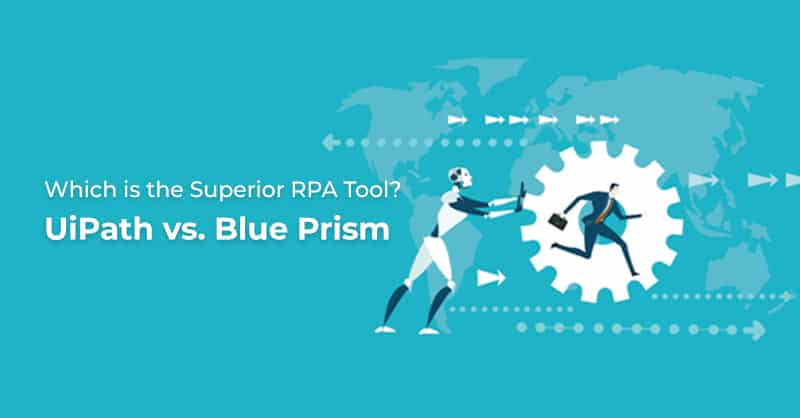UiPath vs. Blue Prism: Which is the Superior RPA Tool?

Written by Asif Hussain
RPA Practice Head at Royal Cyber Inc.
May 29, 2023
Enterprises need technology like an RPA platform to manage automated business processes and have a virtual workforce that can aid employees in carrying out their tasks more efficiently. There are several robotic process automation tools available in the market to choose. However, UiPath and Blue Prism are among the most widespread RPA platforms customers use. Furthermore, assessments by third parties of the overall capability of these RPA tools agree that UiPath and Blue Prism are equally powerful and competitive. Yet it is essential to note that both are significantly different solutions.
Providing some context to the Blue Prism vs. UiPath debate is essential. Blue Prism, now called SS&C Blue Prism (Blue Prism was acquired in 2022 by SS&C), was created in 2001. Blue Prism promotes itself as an intelligent automation platform with a range of BPM and RPA tools that help transform the workforce. Forrester’s study in 2023 has dubbed Blue Prism, a Leader in RPA. One of the leading products highlighted was Blue Prism’s Chorus, a BPM suite offering digital process automation, case management, omnichannel interactions, and operational analytics.
UiPath, which began in 2005, UiPath’s software is designed to be user-friendly and intuitive, with a visual workflow editor that allows users to create and manage automation workflows easily. UiPath’s software’s critical features include Orchestrator, Studio, AI Fabric, and Insights. Incidentally, UiPath has also been recognized as an RPA leader by the Forrester study in current offerings, strategy, and market presence. Read our blog to learn more about how UiPath’s Insights and Automation Hub can accelerate business ROI.
This blog aims to compare the two tools to help people evaluate these two RPA tools and decide which can help their business processes best.
Want to learn how an RPA tool can enable rapid business process automation? Read our case study, discussing how RPA increased efficiency for an integrated communications company.
UiPath vs. Blue Prism: An RPA Tool Comparison
When comparing the two RPA platforms, it is best to compare the capabilities. Therefore, we compare UiPath and Blue Prism along 11 parameters:
| Feature/Aspect | UIPATH | Blue Prism |
|---|---|---|
| App integration | Common apps: both attended and unattended | Common apps: unattended only |
| Scalability | Scalable from small companies to enterprises | Focused primarily on enterprises |
| Pricing | Lower upfront costs Can go up depending on the selected license |
High upfront cost |
| Education & certification | UiPath academy, free community version, certification | Certification available, not much training material available. |
| Community | Robust and active; forum, insider previews, blogs | Less active |
| Recording | Available | None |
| Debugging | Basic | Dynamic and technical |
| Accessibility | Mobile and desktop apps, browser | Desktop app |
| Developers technical Knowledge | Not required (But coding experience improves the speed of development and the quality of end applications) |
Same as UIPATH |
| Talent pool | More developers available | Fewer developers available |
| Ease of development | Easiest to use, faster deployments, visual design | Technically mature but difficult to use |
| Architecture | Client-server | Client server/web-based orchestrator |
Attended vs. Unattended Automation:
Previously, UiPath was the tool that had both attended bots (also termed robotic desktop automation) and unattended robots, while Blue Prism was perceived to have unattended robots. Attended automation is associated with automating more complex business processes, such as responding to customer inquiries and complex data entry tasks. In contrast, unattended automation could operate independently but was capable of only back office automation like system maintenance, report generation, etc. However, Blue Prism has recently introduced RPA solutions like Blue Prism Cloud Interact and Service Assist to help contact workers become more efficient and productive. And depending on your standpoint, some argue that the Blue Prism tool does provide attended automation and always has.
Debugging Capabilities:
Blue Prism outpaces UiPath when it comes to effective debugging. Blue Prism allows you to interact dynamically with variables and scenarios to test and resolve issues. With UiPath, debugging is more challenging as you cannot change variables during testing; you can only view the values during the debugging execution. This feature helps with the entire process of CI/CD. In addition, UiPath relies on the traditional ‘try catch’ activity for exception detection, while Blue Prism has resizable blocks that can be used and altered easily to cover around steps to use the ‘try catch’ functionality.
Readability Process:
UiPath is more limited regarding the readability process due to being of fixed size and limited positional activity elements. On the other hand, blue Prism is superior with its custom-sized, positioned, and color-coded process elements.
Process Flow Capture & Design:
UiPath, capable of automatically waiting for objects on web pages and a macro recording feature, outdoes Blue Prism, which doesn’t have a macro recording feature and needs a “Document Loader” action to wait for an object to load on the webpage. However, Blue Prism, with its object and process separation, is superior to UiPath’s loosely coupled libraries with their imports in processes.
Source Control:
Source control options are in-built in UiPath Studio, where TFS (Team Foundation Server) and SVN (subversion) can be used. However, Git and BitBucket cannot be used. In contrast, Blue Prism allows comparing two versions of the files for conflict resolution.
Deployments of bots:
The processes in the studio can only relate to one UiPath Orchestrator at a time, so teams often have to reconfigure to switch between staging and production. Whereas with Blue Prism, the import-export of packages makes the deployment process more straightforward.
Installation of RPA tools:
The installation process for UiPath and Blue Prism is much easier with a Windows installation package for the UiPath tool. In addition, it is easy to connect the desktop-based UiPath Studio with the web-based UiPath Orchestrator. Thus, the creation and deployment of software robots are easier. They also easily integrate with web services like SOAP, REST, etc.
Application Integration:
UiPath can integrate with many applications, including Word, Email, Excel, etc. UiPath can also identify objects within the images on the screen, including Citrix automation. While the Blue Prism technology is similarly well integrated with other software applications, it is more difficult to identify objects within images on the screen.
Working with Data:
Robotic automation technology was typically only seen to prevent employees from spending time doing a data entry job manually. But process automation and artificial intelligence have come far in data science. For example, UiPath can pick structured data; however, working with structured datatype is difficult, while with Blue Prism, working with structured data and datatypes is simple. In addition, both robotic automation technologies have data encryption capabilities.
Developer Background:
Blue Prism is typically easier to operate if the team members are C# developers, while for UiPath, there is no coding background necessary. However, it is helpful to know HTML, CSS, and VBScript. Concerning the tools used, UiPath uses SharePoint, Kibana, and Elasticsearch, while Blue Prism relies on C#. Thus high-skilled resources for running Uipath are unnecessary, whereas with Blue Prism, a moderate degree of technical expertise is expected.
Accessibility:
Accessibility refers to barriers to entry, certifications needed, and if there is mobile accessibility. UiPath is comparatively more accessible with low-cost entry and a UiPath free ‘Community’ Edition that allows individuals and small teams to use the UiPath platform directly for business purposes. At the same time, Blue Prism requires more investment monetarily. In addition, UiPath has multiple free certification courses like the UiPath Academy website, while the Blue Prism software certification via Blue Prism University is more exclusive. Finally, the UiPath Platform can be accessed on browsers and mobile while Blue Prism has only developed a browser extension with no mobile app.
Need help getting started with which business processes to automate with RPA? Watch our webinar to learn how to scale your business with RPA.
To conclude our robotic process automation tool comparison..
One would say that the UiPath and Blue Prism are among the top-tier business automation tools available in the market. Both tools possess numerous features, and based on this detailed comparison, one thing is clear: the selection of an automation tool depends on the business operations that need to be automated and enterprise capabilities and restrictions.
Royal Cyber Inc. has facilitated businesses by providing enterprise solutions for over a decade; we have successfully performed business process automation and RPA implementations worldwide. We can help you identify your process automation needs and best-suited tools and offer jumpstart packages to get maximum and rapid ROI for you. For more information about running workflow automation for your business, email us at [email protected] or visit us at www.royalcyber.com.
